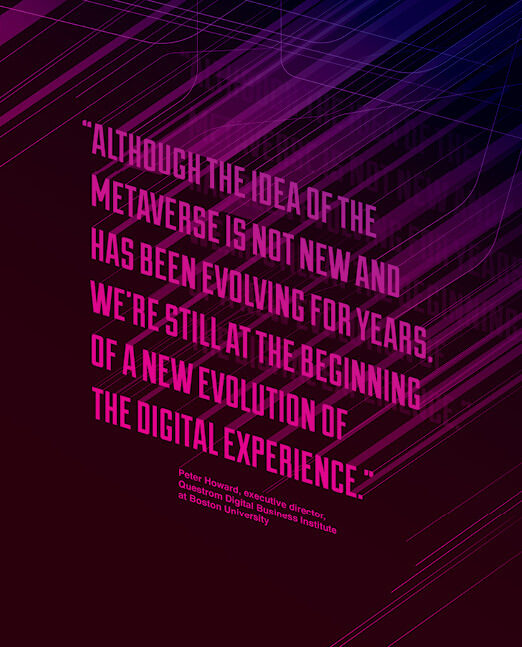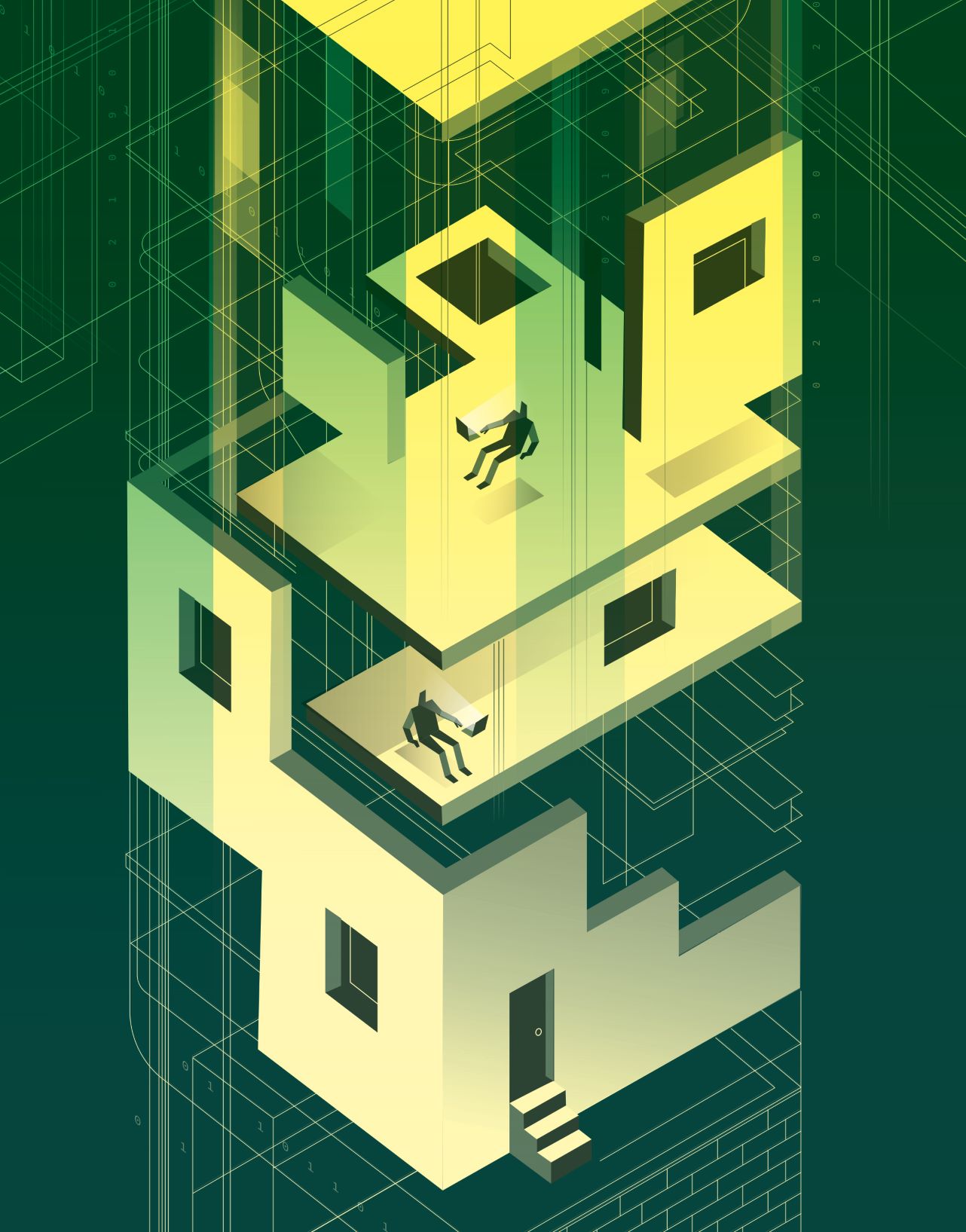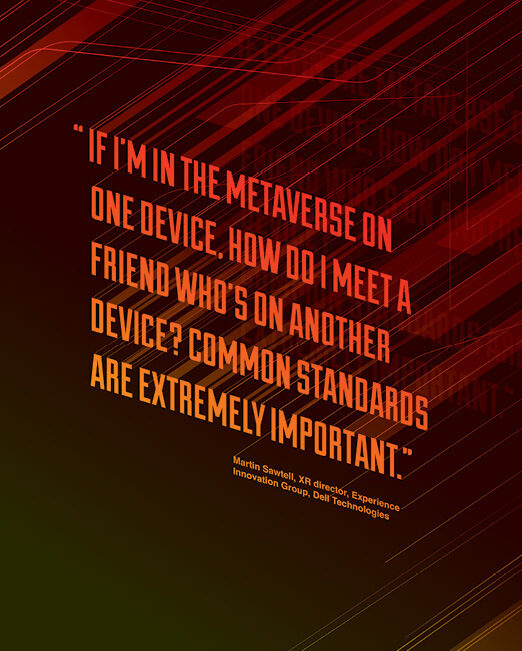By Rodika Tollefson | Illustrations by Harry Campbell
We meet on Zoom or perhaps in Second Life. We hang out in “Fortnite.” We may even watch our favorite pop stars perform live on a virtual stage in 3D avatar form, or we may join the entire family on a virtual reality (VR) hot air balloon ride. Virtual experiences have become a part of our everyday lives.
But what if our physical and digital lives—and spaces—constantly intermingled, regardless of our device preferences? What if we could interact in real time while hopping seamlessly in and out of our physical reality and multiple 3D virtual worlds, without friction or a starting and ending point?
This idea of the two converging realities describes the metaverse—or at least one version of it. While the buzz around the metaverse is creating a fair amount of excitement, the concept itself remains a bit fuzzy. But even if the vision—or the definition—varies, many see the potential of the metaverse to become another touchpoint, a ubiquitous part of our lives.
But what will it take to get there?
The metaverse’s evolving and diverging layers

At its core, the metaverse is not unlike the internet: It’s a collection of protocols, environments, digital assets and mediums that combine to create an interactive experience.
Peter Howard compares the current state of the metaverse with the emergence of the internet in the 1990s. Howard, who teaches digital business and leadership at Boston University’s Questrom School of Business and is executive director of the Questrom Digital Business Institute, notes that, back then, everything from websites to payments were inconsistent and even clumsy at times.
“Although the idea of the metaverse is not new and has been evolving for years, we’re still at the beginning of a new evolution of the digital experience,” he says.
What the actual metaverse experience may look like is a much-debated subject. Some view it as fully immersive and VR-driven (think of the movie “Ready Player One“). Others believe it could simply be a 3D digital overlay on the physical world—more along the lines of augmented reality (AR).
Regardless of the format, providing the experience requires some core components such as infrastructure and content. Beyond that, what technology experts believe is needed for the metaverse to reach its full potential depends largely on the version of the metaverse to which they subscribe.
Infrastructure basics
Martin Sawtell, an AR/VR expert who worked on “Ready Player One,” believes that the film’s fully immersive version of the metaverse is impractical in most use cases. Sawtell, who is now XR (extended reality) director of the Experience Innovation Group at Dell Technologies, looks at the metaverse in terms of what he calls spatial computing—a “new, more intuitive way to interact with computing” without being tethered to a particular space or device.
He believes that, in the near term, the most achievable and accessible approach technologically is by working with artificial, immersive, AR/VR mediums. But in his future version of the metaverse, physical and digital spaces would blend: We could walk into either the virtual or physical space and seamlessly finish an activity we started somewhere else.
Both of these renditions rely on bandwidth-hungry applications, making connectivity one of the key infrastructure components.
“We need to have reliable, quick, low-latency computing,” Sawtell says. “This is going to be a challenge, especially for some groups.”
The adoption of 5G, as well as Wi-Fi 6, will close some of the gaps. Both technologies bring higher speeds and capacity, and the tech industry expects to see innovation in AR/VR applications as a result.
An open experience
 In recent months, many tech players have jumped on the metaverse bandwagon, branding everything from concerts (like Justin Bieber on the Wave platform) to shopping (like Samsung’s 837X virtual store in Decentraland) as metaverse experiences. These represent what this new digital touchpoint may look like, but—ultimately—the prevailing thought is that the metaverse should remain persistent, with no start and end, and span across all types of worlds.
In recent months, many tech players have jumped on the metaverse bandwagon, branding everything from concerts (like Justin Bieber on the Wave platform) to shopping (like Samsung’s 837X virtual store in Decentraland) as metaverse experiences. These represent what this new digital touchpoint may look like, but—ultimately—the prevailing thought is that the metaverse should remain persistent, with no start and end, and span across all types of worlds.
In this kind of continuous digital universe, we could seamlessly bring our identities (and digital assets) with us anywhere. For that, we need an open metaverse rather than the walled gardens that many companies are building. And, for the proponents of an open metaverse, interoperability and standards rank high on the must-have list.
Caleb Applegate calls individual immersive worlds—like “Fortnite,” Roblox or Decentraland—slices of the metaverse. Applegate is the chief operating officer of Enjin, which provides the Ethereum-based cryptocurrency Enjin Coin, along with a series of non-fungible token (NFT) products. He believes these metaverse slices are a necessary first phase, allowing different stakeholders “to explore what a digital world looks like.”
“As everything evolves, the metaverse then becomes open and interoperable,” Applegate says. “And, instead of these siloed worlds, you now have an open universe with a digital avatar and assets attached to your identity.”
Everyday, frictionless accessibility
Regardless of which camp they’re in, metaverse supporters say that usability engineering should be a priority. This includes creating a frictionless user experience so that anyone can access the metaverse, regardless of their device.
Technology entrepreneur and VR pioneer Richard Boyd has been an advocate for the metaverse ever since sci-fi author Neal Stephenson coined the word and introduced the idea of a VR-based successor to the internet in his 1992 book, “Snow Crash.” Boyd says friction is an important consideration.
“I’m always asking, how can I get in and collaborate with other people using rich media communication that doesn’t require installing special software, opening ports or using a device other than what I’m already comfortable with?” Boyd says.
These kinds of design challenges aren’t new, he adds. Web design went through similar pain points, including the need to ensure sites can accommodate high traffic and look and feel consistent across platforms.
“But it’s slightly more challenging for the metaverse because now you’ve got more dimensions and more types of media to work with,” Boyd says.
 Dell’s Sawtell agrees that frictionless access is critical. “If I’m in the metaverse on one device, how do I meet a friend who’s on another device? Common standards are extremely important.”
Dell’s Sawtell agrees that frictionless access is critical. “If I’m in the metaverse on one device, how do I meet a friend who’s on another device? Common standards are extremely important.”
That’s why Sawtell is excited about NVIDIA’s Omniverse, an open-source platform or ecosystem for 3D design that also connects to other popular 3D applications like Epic Games’ Unreal Engine and SideFX’s Houdini.
“NVIDIA Omniverse is tackling the friction problem head on with its open platform,” he says.
Content is still king
The internet wouldn’t be where it is today without meaningful content. Same goes for the metaverse.
Currently, the bulk of the metaverse experiences target gamers. In fact, some people see Epic Games’ “Fortnite” as being as close to the metaverse as we are at the moment. For example, many go there simply to socialize, while virtual concerts and other events have become a staple. And Epic Games solved the friction problem—so common in gaming today—by enabling full cross-play on mobile platforms, PCs and gaming devices.
To entice more people to the metaverse—after all, this new digital space is all about social interaction—we’ll need more content. That’s where tools like Omniverse come in.
The tools democratize the ability to create content in the metaverse, according to Boyd. And Boyd knows content, as well as open standards, firsthand. He co-authored a book on Virtual Reality Modeling Language (VRML), an open-source software developed in the ’90s for interactive 3D design such as simulation. He also helped architect the U.S. Department of Defense open-source Virtual World Framework and launched several gaming companies.
“The metaverse should be like the internet, where anybody who can master standards like HTML or JavaScript can contribute,” Boyd says. “With some basic 3D models and light integration, you ought to be able to build interesting things in these new worlds.”
Tools are one step. Content also requires effort, and creators typically expect some form of return on investment.
Howard uses a virtual, interactive travel world as an example. “Think about what that requires, including a film crew to go and film numerous shots from different angles. Then you need to digitize all that and transpose it to 3D,” he says.
As demand grows with adoption and increased consumerism, so will content availability, Howard believes.
Going beyond theory
Like other new technology ideas, the metaverse has attracted a contingent of skeptics. That’s understandable, considering that the concept has floated around for three decades with limited development. Even now, much of the conversation remains theoretical, while the technologies that underpin the metaverse continue to evolve.
Sawtell, for example, notes, “There are so many unanswered questions about moving to this space.” The sentiment is widely held in the industry.
Despite the unknowns, the metaverse is likely to gain momentum as more technology companies become involved. As Boyd points out, academics and technologists bought into the early concept of the metaverse, but the technology companies weren’t at the table. Now tech companies are driving it forward.
It will take years, perhaps decades, to find out where these efforts will lead. But if the metaverse is anything like the internet—if not much better—it’s hard to see this genie going back into the bottle.
Want to read more stories like this? Check out Realize magazine.

